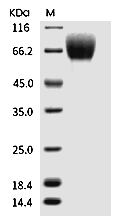Shopping Cart
- Remove All
 Your shopping cart is currently empty
Your shopping cart is currently empty

FGFR1 Protein, Human, Recombinant (alpha (IIIb), His) is expressed in HEK293 mammalian cells with His tag. The predicted molecular weight is 40.5 kDa and the accession number is P11362-7.

| Pack Size | Price | Availability | Quantity |
|---|---|---|---|
| 50 μg | $228 | In Stock | |
| 100 μg | $377 | 7-10 days | |
| 200 μg | $619 | 7-10 days | |
| 500 μg | $1,190 | 7-10 days |
| Biological Activity | Activity testing is in progress. It is theoretically active, but we cannot guarantee it. If you require protein activity, we recommend choosing the eukaryotic expression version first. |
| Description | FGFR1 Protein, Human, Recombinant (alpha (IIIb), His) is expressed in HEK293 mammalian cells with His tag. The predicted molecular weight is 40.5 kDa and the accession number is P11362-7. |
| Species | Human |
| Expression System | HEK293 Cells |
| Tag | C-His |
| Accession Number | P11362-7 |
| Synonyms | OGD,N-SAM,KAL2,HRTFDS,HH2,HBGFR,FLT-2,FLT2,FLG,fibroblast growth factor receptor 1,FGFR1 α (IIIc),FGFR-1,FGFBR,CEK,CD331,bFGF-R-1,BFGFR |
| Construction | A DNA sequence encoding the human FGFR1 alpha (IIIb) (NP_056934.2) (Met1-Lys310 and Ala359-Glu374 linked by FGFR1 IIIb Ig domain (AAB19502.1) (His1-Pro47)) was expressed with a polyhistidine tag at the C-terminus. Predicted N terminal: Arg 22 |
| Protein Purity | > 95 % as determined by SDS-PAGE.  |
| Molecular Weight | 40.5 kDa (predicted); 60-90 kDa (reducing condition, due to glycosylation) |
| Endotoxin | < 1.0 EU/μg of the protein as determined by the LAL method. |
| Formulation | Lyophilized from a solution filtered through a 0.22 μm filter, containing PBS, pH 7.4. Typically, a mixture containing 5% to 8% trehalose, mannitol, and 0.01% Tween 80 is incorporated as a protective agent before lyophilization. |
| Reconstitution | A Certificate of Analysis (CoA) containing reconstitution instructions is included with the products. Please refer to the CoA for detailed information. |
| Stability & Storage | It is recommended to store recombinant proteins at -20°C to -80°C for future use. Lyophilized powders can be stably stored for over 12 months, while liquid products can be stored for 6-12 months at -80°C. For reconstituted protein solutions, the solution can be stored at -20°C to -80°C for at least 3 months. Please avoid multiple freeze-thaw cycles and store products in aliquots. |
| Shipping | In general, Lyophilized powders are shipping with blue ice. |
| Research Background | FGFR1, also known as CD331, belongs to the fibroblast growth factor receptor subfamily where amino acid sequence is highly conserved between members and throughout evolution. FGFR family members differ from one another in their ligand affinities and tissue distribution. Fibroblast growth factors (FGFs) (FGF1 - 10 and 16 - 23) are mitogenic signaling molecules that have roles in angiogenesis, wound healing, cell migration, neural outgrowth and embryonic development. FGFs bind heparan sulfate glycosaminoglycans, which facilitates dimerization (activation) of FGF receptors. FGFR1 is a full-length representative protein consists of an extracellular region, composed of three immunoglobulin-like domains, a single hydrophobic membrane-spanning segment and a cytoplasmic tyrosine kinase domain. The extracellular portion of FGFR1 interacts with fibroblast growth factors, setting in motion a cascade of downstream signals, ultimately influencing mitogenesis and differentiation. This particular family member binds both acidic and basic fibroblast growth factors and is involved in limb induction. CD331 can be detected in astrocytoma, neuroblastoma and adrenal cortex cell lines. Some isoforms are detected in foreskin fibroblast cell lines, however isoform 17, isoform 18 and isoform 19 are not detected in these cells. Defects in FGFR1 are a cause of Pfeiffer syndrome ,idiopathic hypogonadotropic hypogonadism, Kallmann syndrome type 2, osteoglophonic dysplasia and trigonocephaly non-syndromic.Cancer ImmunotherapyImmune CheckpointImmunotherapyTargeted Therapy |

Copyright © 2015-2025 TargetMol Chemicals Inc. All Rights Reserved.